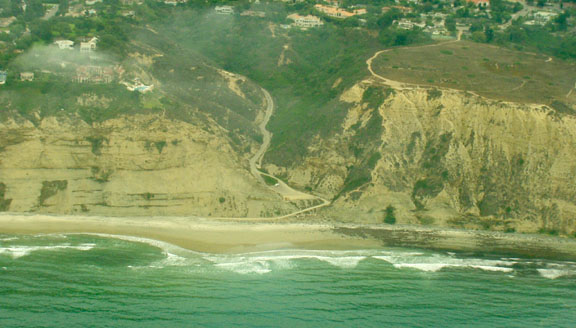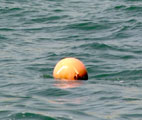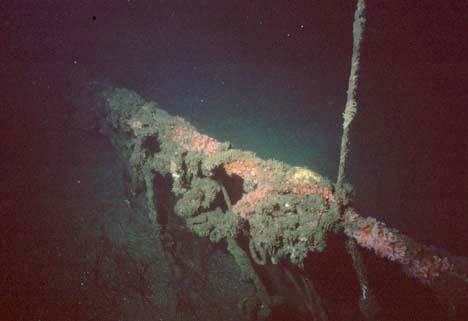Scripps Area Dive Sites

MAP (PDF file, 163 KB)
(Map © Anders Rindell, used with permission.)
The UCSD dive club, the Seadeucers, used to dive this site several times a week back in the days when they were active and when UCSD would allow them to use the key to the gate at the top of the road down to Black's Beach—shown in the photo above; Scripps Canyon itself would be just off the right edge of the photo). Some of the divers who were active with that club do occasionally get access to the road and diving with them is the easiest way. Below are directions for doing it on your own:
This is a mild workout. If you don't like to walk and swim, or if you're in bad shape, don't try this (odds are that you shouldn't then dive Scripps Canyon at all, but if you must, then do it with those who have the key). Getting to this dive site without having a key to the UCSD road down to Black's Beach involves approximately a 15 minute walk and a 30 minute surface swim, wearing your wetsuit and all of your gear. (Don't do this in a drysuit unless it's a foggy, cool day.)
This route should only be done early in the morning, on a low tide, when the surf is low. Why early morning? It's cooler. Why low tide? You need to walk as far north as you can towards the rocky point between Scripps and Black's Beach (roughly at Dike Rock), and you can only do this at low tide. Why low surf? With anything but low surf you will get creamed on the entry and the exit (especially the exit) and will have a hard time seeing the marker buoy on your swim out.
Meet at the Scripps Institute of Oceanography parking lot on Paseo Grande in La Jolla Shores. This is the parking lot at the southern-most end of SIO, where the surfers gather. If you can, park for free on Paseo Grande, but be certain to bring nine quarters to park in the lot. The meters hold a maximum of eight quarters, for two hours, which is about what the dive will take you. When everyone is gathered, put one quarter in your meter, grab your binoculars, and walk down the SIO road to the end of the pier. Stand on the end of the pier, looking north, and do a conditions check. Use the binoculars to ensure that the buoy is still on station. To find the buoy, look at the rocks in the water near the rocky point. Find the large rock closer to you which looks like it is notched at the top (Dike Rock). Look behind this notched rock for the buoy.

If conditions are good, then return to your car and gear up. There is a port-a-potty next to the small building right next to the parking lot; it tends to be quite nasty, so try to plan accordingly. Further down the sidewalk on which the port-a-potty sits is a shower.
When everyone is geared up, put your remaining eight quarters in the meter. Walk down the SIO road, past the end of the pier, down the ramp by the SIO diving locker, and onto the beach. The ramp is very steep, please separate yourselves, so that if one person falls they will not knock down everyone else. Walk north on the beach as far as you can go, which should be just short of the point. You will be on a little stretch of beach between the notched rock and the point; there are fewer boulders in the water here. Wherever you are in the water here, watch for large underwater rocks. Get out just past the surf zone and turn basically north, parallel to the shore. If you point your feet in the general direction of the base of the pier, you will be headed approximately towards the buoy. Kick. Kick some more. Remember that, no matter where you are, if someone asks how far it is to the buoy, the answer is "about another 100 feet". Every so often, turn and spot the buoy to correct your course.
Once you find the buoy, get yourselves ready and descend down the buoy line. You are descending in about 70' of water. The buoy line is tied off on the cable which runs across the top of the draw (which leads west into the canyon, and is in fact the canyon itself before it opens up). Look at the growth on the cable and spot your first nudibranchs.

From the cable, you have two main options:
Option 1: Go under the cable and down the draw. This is a narrow draw, dropping steeply into the canyon. You will get to 130' very quickly. There are several ledges in the draw, including a major one at about 135', after which it drops another 30' or so (on a good day you can see the next ledge). Pull out of the draw at that ledge or anywhere above it where you like the depth. Stay to the right hand (north) wall. On good days, you can see from the north rim/wall to the south rim/wall. The north is more interesting. Follow the wall around, past a serious crevice and around a rounded point. Watch your depth... this is real wall diving. In places the wall actually hangs back over you, forcing you to move backwards as you move upwards. Watch for nudibranchs, which are everywhere. Look for moray eels and swell sharks in the cracks.
Option 2: From the cable, stay up on the rim of the canyon on the right hand (north) side, at about 80'. Work your way along the rim until you pass over a very small cutback in the canyon and then come upon a large drop-off as the canyon jogs to the right. Go over the rim at this point (just short of the serious crevice) and begin your wall dive. This option tends to end up giving you a shallower dive (100–110' instead of 130') and more time at depth exploring the wall.
If/when you get around the large, rounded point past the crevice, go to about 100' and look for a large crevice in a depression. You may find a moray eel or swell shark in there.
When you get to one-half your air or to your predetermined No Dec Limit, come up out of the canyon. The top lies in about 75' of water. If you've rounded the corner towards Sumner Canyon, then cross back southeast to the rim of the canyon near where you entered. If you feel brave, blue water swim over the top of the canyon at about 75' deep (the other side is quite close). If not, then return to the cable and cross to the south side there. Either way, take a compass heading of 170 degrees and start kicking. Go as far south as you can, trying to make it at least back past the notched rock.
When you surface, take some time to watch the waves breaking, to see where they're lowest and to watch for submerged rocks. The closer you get to the pier, the larger the breakers get.
Walk back to the showers and to your cars, and see how much time you've got left on your parking meters!

Park as you would for Scripps Canyon, but go for a much shorter walk. This is a shallow dive, 20–25' maximum, near a lot of very hard pilings, so don't dive here if there is good surf! If it's a good surf day, enjoy watching all of the surfers gathered at the nice breaks near the pier, and then go dive somewhere else. If it's a good diving day, then go for it. Descend anywhere you want to along the pier, and enjoy exploring around the pilings. They are completely encrusted with life. You will see sea stars in pastel colors you've never dreamed of. Look for small life hidden amongst all the barnacles. Watch for rays on the bottom. But most of all, DON'T TOUCH ANY OF THE EQUIPMENT / INSTRUMENTS THAT YOU SEE DOWN THERE. Remember that this is the Scripps Institute of Oceanography and that we LIKE the ocean and the people at SIO and we don't want to hurt their equipment. Thank you!